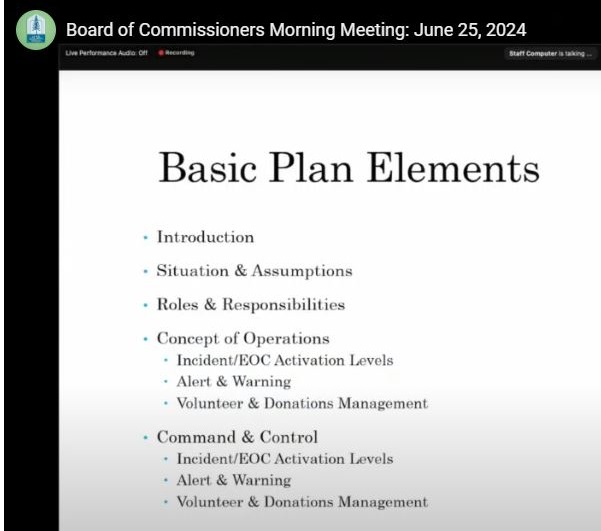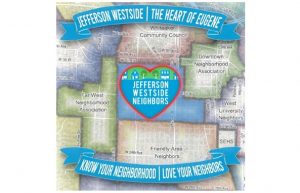Lane County updates emergency plan, will offer training schedule
4 min read
Involve the whole community and start practicing together. That was the message Lane County commissioners heard June 25.
Commissioner David Loveall: I love the one you just had up there that said, ‘You fight like you train.’
[00:00:13] Commissioner Ryan Ceniga: I also wrote down, ‘You fight like you train,’ so actually going through these motions and the more times we do it, the more natural it’s going to get.
[00:00:24] Commissioner Pat Farr: Now when there’s a broad emergency, sometimes we’re more on our own and that’s when we really ‘fight like we train.’ That is really, when we, if you train with fervor, then when it’s time to use the skills that you’re training on, you use them with fervor also.
[00:00:39] Commissioner Laurie Trieger: I love the whole community planning, just as a phrase, and I’m asking you, administration and our policy director, to think about what you might be able to bring to us as a training or a support guide or document for what the board’s role is, specifically, when we have to activate.
[00:00:55] John Q: Lane County updates its emergency operations plan.
[00:01:00] Tiffany Brown (Lane County, emergency manager): So today we’re here to approve the basic plan. It is one piece of the county emergency operations plan. It is the only piece of the county EOP that is public-facing. The other components have more operational and more specific information about people and places and property that we refer to as FOUO, For Official Use Only.
[00:01:25] This plan really has mostly to do with the county emergency operations center. It really is a high-level document that helps us as the county emergency operations center support those more operational partners.
[00:01:38] So our concept of operations at the EOC level is incident and EOC activation levels; how we alert and warn the public and communicate with our other partners. Volunteer and donations management is another example of something considerable that we handle during an event.
[00:01:54] This plan outlines how those roles and responsibilities change from when we’re having a blue-sky day, and when an incident occurs and we’ve activated. Next, we train and exercise, and then we just perform routine maintenance of these parts of the plan that tie directly to our emergency operations.
[00:02:14] John Q: She said the plan incorporates lessons learned from the ice storm.
[00:02:19] Tiffany Brown (Lane County, emergency manager): This, in a small way, is a little bit of an extension of the after-action for the ice storm debrief. Because it is some of those items that really translated into where we put our efforts for ’24-’25. If you think about a five-year update, it puts us on a cycle of kind of looking at those ESFs (emergency support functions) every year.
[00:02:39] So these are the priorities for the upcoming year based on what I learned during the after-action and what we heard from our partners. The first will be with the EOC activation, notifications and thresholds: How we decide to activate, what level we activate at, and how we let people know that we have done so.
[00:02:58] ESF 2 is communications. This is a big chapter. It includes a lot of different things. But for now we’re going to focus on increasing use of Lane Alerts, both internally, meaning for our agencies and our county staff and departments, but also externally with the public. We’ll be establishing training and education, a governance and use model for using the system, and kicking off a public marketing campaign for that public-facing piece.
[00:03:26] Mass care is a piece, as you know, that we really uncovered the complexities of during the ice storm. Moving forward, we’re going to start by developing an assessment of our mass care environment, what it is, what we’re talking about, who we’re talking about when we’re talking about providing food, warmth, shelter, and basic medical to the community, under what circumstances.
[00:03:50] And from that start to perhaps operationalize that assessment in terms of understanding who does what and what happens differently when we are managing mass care in a heat situation or a smoke situation and the EOC is not necessarily activated and then how we transition smoothly into that full activation.
[00:04:12] Finally, this is about the EOC training programs, a desk to serve as liaison for our utility partners and volunteer and donations management. We have partners that are eager and ready to come and help in this work and support us at the county emergency operations center. We’re working, we’ll be working with them to develop those training materials and then turn around and roll out training and exercise opportunities to come back.
[00:04:38] Really, the trick in all of this is: ‘Practice, practice, practice.’ And we’ll be setting up a regular training schedule in order to meet those needs.
[00:04:50] Commissioner Pat Farr: I think back historically, back in 2013, we began working on an emergency plan. We didn’t have one at the time. The lead at the time was Steve Dingle, who was county counsel. That’s how close to ground zero we were. I mean, we didn’t have any emergency response system.
[00:05:05] The first thing that we did back then was we made sure that all county commissioners were in contact during an emergency. It was that basic, the plan that we had at the time. And look at what we have today. We really are respondent. We’ve had an opportunity to practice.
[00:05:21] Don’t like practicing, but practice does make you better at the things that you do, and doing them with fervor once again, and doing them in cooperation and coordination with adjacent jurisdictions.
[00:05:32] John Q: Emergency Manager Tiffany Brown updates the emergency plan and looks ahead to a regular training schedule.



